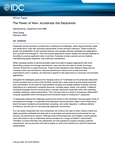Brazilian telecommunications company TIM is on track to exit its data centers by the end of this year, reports BNamericas.
By August, the company had moved around 85 percent of the workloads intended for the cloud. Since then, the company has completed the migration of its online charging system (OCS), one of the telco's largest workloads.
All that remains, according to TIM's CIO Auana Mattar, is the "long-tail process and migrating smaller systems."
The OCS move was completed on September 15, 2023, and is one of the most important elements of TIM's functions as it means the telco is able to charge users for services in real-time. The system, provided by Huawei, was originally supposed to be migrated by July.
In total, TIM is moving two data centers to the cloud: its Santo André and Rio de Janeiro facilities. This adds up to more than 8,000 workloads and 16 petabytes of storage. Once completed, the company will be hosting its analytics technologies on Google Cloud Platform. Its databases and back-end process on Oracle and its digital channels and front end applications will be hosted on Microsoft’s Azure.
The company first announced its cloud migration project in 2020, and in 2021 began the process, which was still running smoothly earlier this year.
Mattar says the migration has enabled TIM to launch new services quicker than before, and the company has begun to test new applications including generative AI.
TIM S.A. is a subsidiary of Telecom Italia Group. The company has been operating in Brazil since 1998, and at the end of August 2023 had 62.8 million customers. The company launched its data center in Santo André in 2004. The data center is part of a "technological hub" which also includes a call center, administrative buildings, a documentation center, and an energy and utilities substation. The hub cost R$262 million at the time - around R$759.8m (US$151.63m) today.







